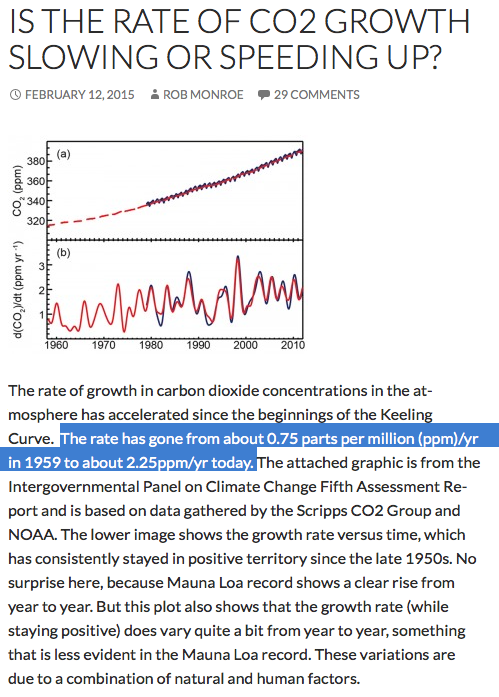Watts study + Keeling Curve = Enhanced climate skepticism.
Anthony Watts reported yesterday that the increase in the 30-year US temperature trend is reduced by 30% when the analysis is limited to high quality, unadjusted, no urban-heat-island-affected NOAA weather stations.
Now consider that the rate of CO2 emissions has tripled over the past 56 years, according to this Keeling Curve post:

So we have 30% less warming despite 300% more CO2 emissions over the recent past. We should all be skeptics.
The physics of the (misnamed) “greenhouse effect” of CO2 causes additional CO2 to have a logarithmically diminishing effect on temperature, due to saturation of CO2’s main IR absorption bands. MODTRAN calculates that ~20 ppmv (and the NCAR Radiation Code calculates 40 ppmv) of CO2 would generate half the warming produced by the current 400 ppmv.
I ran the numbers through the U.Chicago’s online MODTRAN interface, and found that for a tropical atmosphere with cumulus 0.66km-2.7km, and const rel humidity (to account for water vapor feedback/amplification) a doubling of CO2 (from 285 to 570) was calculated to result in just 0.81°C of warming. (That’s a calculation of tropical “climate sensitivity.”)
The tropics get a disproportionate amount of sunlight, so that’s where GHGs matter the most. But farther from the equator sensitivity should be slightly higher, because the air is dryer, so water vapor amplification increases. So round up, and call the predicted global climate sensitivity from MODTRAN “about 1°C.”
That’s consistent with a plausible scenario in which about half of the warming seen so far is natural, and the other half is man-made.
I did the same thing with the NCAR radiation code (const rel hum 70%, CH4 1.8 ppm, N2O 0.3 ppm, low cloud 30%, high cloud 25%), and it calculated 1.8°C.
That sensitivity is consistent with a scenario in which most of the warming so far is man-made.
The correct number is probably somewhere between those two (probably less than the IPCC’s 1.5°C target).
Either way, it’s important to note that, because CO2 has a logarithmically diminishing effect on temperature, we’ve already seen nearly half of the warming effect of that doubling, with no hint of catastrophe.
Those are not worrisome numbers.
Moreover, with the Sun entering a Dalton-like or perhaps even Maunder-like minimum, a little extra warming should be very welcome.
http://www.sealevel.info/Sunspot_Numbers_2015_whiteBG_25pct.jpg